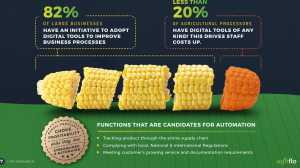Closing the loop for Workflows in Agricultural Processing

In Agriculture you hear phases such as “Industrial Internet of Things”, closing the loop on you data, and connecting to the supply chain. This can sometimes feel as if the world in Agriculture is finally catching up to technology or it can feel as if technology in agriculture is out of control. Either feeling ultimately comes down to your workflows and technology.
In Agriculture, efficiency of how we work comes to be a fact of life. If we touch the product too many times during processing, this will impact our margins. We know this as processors, but if you have learned to leverage your technology and enhance your workflows so that they are tightened up, it will allow you to be more efficient, increase your profitability and increase your volume into the supply chain.
By connecting the dots with your workflow and technology, it allows you to have better management in your data. This means you can actually use it to make real time decisions. Rather than trying to decipher what happened yesterday or last week and trying to piece everything together. If the workflow and the technology are working together, this will prevent workarounds and errors that can have an impact on your customers.
Workflow and technology working together can provide:
- Reduction in Human Errors or inconsistencies.
- Increase efficient operations for higher volume of output.
- Quicker processing in the agricultural Supply chain.
In the UK there was a recent study that showed that customers sited higher sales as one of the top benefits of using supply chain integrated technology which allowed them to tighten up the workflow processes.
The biggest challenge for the processor is that some off the shelf technology may have limitations in allowing the processor to maximize efficiency and may impact their bottom line. Hence why workflows may not be tightened up or there are just too many work arounds that will occur just to get the product out the door. This type of situation can actually hinder the through put of the plant.
In order to mitigate this scenario you will need to have your workflow and technology working as one. Certain software such as Agriflo has the ability to graphically illustrate your workflow to help you manage it throughout the process. Agriflo software will allow you to change that workflow so that you don’t have to change your software. It will allow you the capability to tighten up the workflows and increase your productivity. The software will grow with you. Agriflo really becomes an extension of your team.
If you would like to learn more!
Check us out: www.agriflo.biz
Agriculture, What Next?
- What’s Next
Agriculture, What’s Next?
As technology becomes an increasing part of our everyday lives, more and more examples can be found in the agriculture world. A great example of this can be found in precision agriculture where farm machinery is getting connected to artificial intelligence and with websites and the management of big data.
It can even be found in the processing of seed, feed, food and grain where technology is beginning to play an important role in processing with new tools of (AI) artificial intelligence and blockchain.
This technology can deliver instructions in a farmer’s native language, including when to sow their crops and has led to a 30% increase in yields for those farmers. This is an example of a successful ‘App’ which was created by using the Microsoft Cortana Intelligence Suite, which includes machine learning and is powered by people in order to create the optimal date/best time to sow.
Farmers who participated didn’t need to install any special apps on their devices and could receive the information via text messages. These farmers in India sowed their seeds early and the ‘App’ was especially helpful during monsoon season.
This is just one example of how AI can help farmers to actually utilize their seeds in an effective and timely manner to help them with increasing their yields.
Processors can use AI in a very similar manner, by learning how to effectively manage their plant’s times which will increase their rate of return on investment and/or increase their KPIs.
AI has the ability to examine the tasks that are being performed, look at the big data and then determine insights and make predictions. It can be as simple as taking a “snapshot” picture of a business and giving a diagnosis of what’s occurring in the plant and what needs to happen. Or it can be more complex with many different aspects of many different controls, ultimately helping your business to ensure that there is excellent quality in the plant.
Ultimately AI is the automation of tasks. These tasks and the information garnered from them will never get missed. AI doesn’t seek out the replacement of key individuals in your process, instead it enhances their industry and experience knowledge and allows better and innovative decision making which helps companies become highly effective with increased KPIs.
If you would like to learn more about Agriculture Technologies and Agriflo. Please contact us
Fully Integrated Systems
Fully Integrated Systems

What are the best reasons to have Fully Integrated Systems in Agriculture?
Fully Integrated Systems reduce the amount of re-entry and reduce the amount of re-work. By fully integrating your processes on the farm or in the processing facility, you are able to do more with less. By connecting the system to the shop, you can receive real-time information and gain the ability to make decisions very quickly which will increase KPIs. Within your facility this could be as simple as connecting your agris system to your accounting system or it could be as simple as having one central source of information. Studies have shown that manufacturers or processors can actually improve their business in terms of productivity and terms of financial gains by 30-40%.
Fully integrated systems actually help you in the tracing and tracking process, especially when the need is to quickly identify immediate issues. A closed loop system can actually minimize errors and allow you to work ON your business rather than IN your business.
In order for a closed-loop system to be successful, three key features need to be addressed. People, Processes and Tools. If you train your people to work within the closed loop system you will reduce re-work and reduce re-entry and this allows you to have the appropriate tools for decision-making to happen in a quick timeline. It will also help you uncover errors faster and give you the ability to deal with them as in a timely manner. A closed loop system can actually help you and your employees have a complete snapshot of your company.
If you would like to learn more about fully integrated systems or Agriflo. Please contact us
Technology and Agriculture

Technology and Agriculture

Technology has drastically impacted Agriculture in many different ways over the last several years. Examples of this impact can be seen with the use of drones by farmers, Real-time analytics that can be pulled from precision Agriculture and even in Agri-processors who have Automation in their facilities to help receive grain with more efficiency.
With new technology moving in fast for Agri-Processing there is definitely an informational gap occurring between the processing plant and the office. This can detrimentally impact the company’s bottom line. This separation is like a fog (or White Space), where you and your employees really do not know what is happening in the fog at any given point in time.
Delays can impact:
- People
- Process
- Tools
These delays can be reflected negatively in inventory accuracy, operational efficiency or even compliance and food safety issues. Any of these problems are cause for concern , but what really hurts the processor is the inability for real-time decision making.
Communication:

Communications need to be linked between the plant and the office because when they are not your company creates White Space. With white space, a company’s communication becomes very “silo’d” with “me” centric tools and this can cause disjointed workflows. A great example of “me” centric tools are email clients such as Outlook or Outlook 365. These programs serve a purpose in our individual workflow and help us in our day-to-day flow, but as a team platform they can be quite limiting. The “me” centric tools cause a huge amount of repetition work, where employees are touching items 4-5 times, or reworking and reworking in order to push items forward. This cycle can lead to frustration at the end of the day, processes can be stalled and employees can feel that they are on a never ending treadmill with no forward momentum to complete tasks.
By connecting your “me” centric tools to workflow automation, accounting systems and even to your Customer forward facing CRM (Customer Relation Manager), it can improve your communication 10 fold, and allow you to be more proactive in your decision making.
Workflow:
If there is White Space between the Processing plant and the office there will be a definite impact on workflow. Delays in processing can impact the bottom line or the company’s key performance indicators (KPIs). The goal becomes reducing white space by connecting the tools, processes and people to the workflow.
This can be achieved by integrating existing tools to help you with the interoperability of the company. Or by reviewing your current needs and looking at your future needs to help you find tools that may be a better fit for your company. By closing the loop of the workflow, it will allow you to lean out processes, empower your people and more importantly, grow your business.
Getting rid of, or reducing White Space can be a challenge because of processes that may not have changed in several years or may be from a time where you were managing your business with much smaller sales volume. If so, this is the best time to review your processes, and see what needs to be changed, improved or even removed. If your company is planning to change processes one key point that will ensure higher rates of success is to engage your employees and team members in this process. They have the experience and likely know better than anyone else, what already works and what doesn’t.
Technology:
Challenges that can make existing problems worse is when a company runs to Technology and throws it at their problems hoping that it is a quick fix. This is a dangerous decision and often leads to failed technological implementations, or high staff turnover. If new technology is the solution for your company then it is wise to slow down before you speed up. There has to be a deep drive to review your company’s needs (People, Process and Tools). Luckily, there are tools that can help you with this review and will give you the extra knowledge to make an informed decision. It is always better to change things in small bite size pieces so that you can really see the outcomes and it will also provide your company time to adjust without hurting your business.
Why should we connect?

There are many different types of challenges facing those of us in Agribusiness; we have challenges with Customers, Producers and even getting our product in and out in a timely manner. Our decisions have to be quick and accurate, which means that our decisions have to be made in real time. The world appears to be speeding up and our decision making has to follow. The biggest problem is what information do we need to make real time decisions? You may have heard of concepts like Big Data, Internet of Things, connectivity, inter-operability and Industry 4.0. Which are the ones you should consider?
1) Connectivity:
In order to gather the best information, we need to make sure that we are connected. This works best in closed loop systems so that all the important information is being captured. In recent years the ability to have a closed loop system has become far easier with PLC (Programmable Logic Controllers) and Automation Controls on the farm and in the processors’ plant. If you haven’t already connected these areas then it should be a top priority, because once you connect these areas together it will allow you to understand how your company is working.
An issue of connectivity is that there can be a shifting constraint. A shifting constraint occurs when you start connecting the pieces to close the loop and unsurprisingly problems will be found in your current processes, these are the shifting constraints. As you tackle and resolve the constraints as you discover them you may notice a shift to a new constraint. This eye opening process will be resolved once all the problems are corrected, allowing a much more efficient process for your everyday activities. This may be a little bit scary or may take some time and effort from employees and management, but I always tell people it is better to slow down in order to speed up. The result will be totally worth it.

2) Inter-operability:
Inter-operability is different from connectivity because it may not be a seamless integration. The concept of inter-operability is knowing that you have data that could be used in your decision making but realizing that you may have to pull this information from the source using third party tools or the ability to export. This can be a small extra step. However, implementing this type of communication strategy, even if they are third party tools will allow you to get information and data that can be vital when making rapid decisions and allows you the ability to stop relying on historical information.
These types of solutions can have challenges because sometimes the pieces may not be able to pull the information that you really need or want. This is when a cost benefit will have to be examined and a decision will have to be made about if it is worth while to make small changes and put something in place to help with the capture of information. Or do you leave it until it makes sense to change in a big way. In either scenario, you will need to be gathering information to help you decide.
3) Big Data:
Big Data is a very popular concept in the business world today. The idea that we should always be plugged in and pulling information from all the sources we can is pervasive and encompassing. The idea is that – More information is always better! However, is this actually true? Sometimes this is not always the case. Companies and Individuals can experience a situation called Analysis Paralysis. This occurs when we are getting too much information and then we can not even fathom where to start. I have come across this situation multiple times, people believe that if they pull every bit of data that they will find some pattern, or trend that will give them the “A-ha moment” to solve their problems.
However, the trick to Big Data is knowing what we need to measure and then to start from there! Even if we only focus on our top three issues in our business, imagine how much of a benefit that would be! In this case you could actually do more with less!
In closing the key to success in connectivity and Big Data is to start small and work towards your goal! By taking off bite size pieces, it makes the goal of true connectivity achievable for any company.

